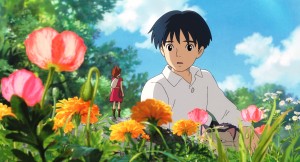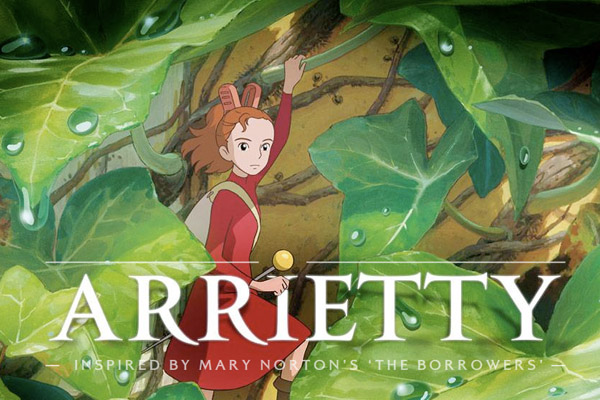Embassy of Japan in the UK Webmagazine (March 2012)
Embassy of Japan in the UK Webmagazine round-up. Posted by JET alum and current editor of the webmagazine, Dipika Soni (Ishikawa-ken, 2003-06). To subscribe to the Embassy of Japan’s monthly webmagazine, email webmagazine@ld.mofa.go.jp with the subject ‘subscribe’.
——————————————————————————————————————————–

Embassy of Japan in the UK Webmagazine: March 2012
Ambassador’s blog
One year on
Featured article
ONE YEAR ON: SCENES OF RECONSTRUCTION & PICTURES DRAWN BY THE CHILDREN OF TOHOKU
Other articles:
Events around the country as the UK remembers “One year on…”
The Tsunami and the Cherry Blossom
One year on: A JET perspective
Films at the Embassy: Bloom in the Moonlight
Films at the Embassy: Tohoku Special Film Show
JAPAN-UK Events Calendar
Justin’s Japan: March Movies at Japan Society, New York International Children’s Film Festival

Makoto Shinkai’s ‘Children Who Chase Lost Voices from Deep Below’ is a modern-day Orpheus tale with a sci-fi twist that pays tribute to the great works of Hayao Miyazaki. (Courtesy of GKids)
By JQ magazine editor Justin Tedaldi (CIR Kobe-shi, 2001-02). Visit his Japanese culture page on Examiner.com here for related stories.
Oscar season may be over, but this month offers a score of cinematic delights from Japan Society and the New York International Children’s Film Festival.
As part of its Love Will Tear Us Apart Globus Film Series, Japan Society presents outré love stories from Japan and Korea, including the U.S. premiere of Shinya Tsukamoto’s KOTOKO (March 2) and the world premiere of Koji Wakamatsu’s Petrel Hotel Blue (March 7) among 23 seminal films from the genre.
Other highlights include Hirokazu Kore’eda’s Air Doll (March 3), Nagisa Oshima’s arch-classic In the Realm of the Senses (March 16), Yukio Ninagawa’s Snakes and Earrings (March 16), Lee Sang-il’s Villain, (March 9) Lee Chang-dong’s Oasis, (March 18) and Kim Ki-duk’s Bad Guy, (March 10), among other twisted tales of star-crossed lovers on the rocks and on the run. (Click here for a complete list of films and showtimes).
For younger cineastes, the critically acclaimed New York International Children’s Film Festival kicks off its 15th anniversary event from March 2-25 at New York’s DGA Theater, Walter Reade Theater, IFC Center, Peter Norton Symphony Space, Asia Society, Scholastic Theater, and Cantor Film Center.
The nation’s largest festival for kids and teens will present four weeks of ground-breaking and thought-provoking new works for ages 3-18, with 100 new films, opening and closing galas, new feature premieres, six short film programs, filmmaker Q&As, filmmaking workshops, and the NYICFF Awards Ceremony. This year’s edition features three Japanese films from 2011.
For the complete story, click here.
Job: Translator for Fukushima Panel Event (NYC)
By JQ magazine editor Justin Tedaldi (CIR Kobe-shi, 2001-02). Visit his Japanese culture page on Examiner.com here for related stories.
The producers of this year’s New York Peace Film Festival are seeking a translator for Sunday, March 4 and Monday, March 5 to assist with events leading up to the actual festival the following week at the Unitarian Church of All Souls.
The producers are now coordinating with local activists and guests from Japan for an entire week of events relating to Fukushima. There will be an energy expert, professors, and a worker from the crippled Fukushima Daiichi and Daini nuclear plant, who will speak to the public on March 5 at Riverside Church, and for emergency workers and first responders including doctors and others at Manhattanville College on March 6.
Due to the nature of panelists and audience on March 6, an able translator and interpreter is needed. This will be paid work. For more information, please e-mail NYPFF executive producer Yumi Tanaka at yumicomic [at] gmail [dot] com.
To read an interview with Yumi on last year’s New York Peace Film Festival, click here.
Submissions sought for JET-organized Toyama Film Festival
Jonathan Dao, the current ALT PA for Toyama Prefecture, is organizing a fundraiser for Make a Wish Japan, Hokuriku and shared the below information and rather entertaining video:
Love movies? Well, we are pleased to announce the first-ever Toyama Film Festival— and in consequence, the CALL FOR SUBMISSIONS. You’ll have three categories to choose from (or maybe you’ll even submit an entry for each):
Movie Trailers/Commercials (1 minute)
Keep it short and sweet. Spoof an existing product or showcase your own!
Karaoke/Music Videos (5 minutes)
We’re all aware of those unforgettable videos that play along when you’re belting out your favorite tune. Think you can do better? Think you can do worse?
Any musicians looking to self-promote are free to submit a little something-something of their own as well.
Short Films (5 minutes)
Give yourself the ultimate challenge of churning out a five minute flick. You’ll just have to watch your pacing. Then again, you could always submit a scene from a longer piece of work. Let the audience watch your ending first? You could be the next Tarantino!
RULES:
There is no submission fee
Anyone and everyone is free to participate
Entries must be in either English or Japanese (subtitles are appreciated, but not necessary)
Participants may submit as many entries as they like*
Entries are DUE APRIL 14TH for review
We’re in the process of securing the venue, but the tentative date for viewing said entries will be Saturday, May 19th. Ticket prices will be only 500 yen, with all proceeds going to Make a Wish Japan, Hokuriku.
For any questions, comments, or troubleshooting concerns, feel free to contact Jonathan Dao at johnnys.second.opinion@gmail.com
Stay tuned right here at facebook.com/ToyamaFilmFest for more!
Jen Wang (Miyagi, 2008-09) is a lab tech in Dallas and a staff writer for the Japanese music website Purple SKY. Her love of cosplay and her junior high school students inspired the name for her own Japanese pop culture blog, Hibari-sensei’s Classroom.
For their 28th annual KidFilm Festival, USA Film Festival paid tribute to Studio Ghibli by screening 10 of its films, plus Nausicaä of the Valley of the Wind which was made before the studio’s founding. Since The Secret World of Arrietty was sold out, I decided to catch Pom Poko with some friends. I had heard some odd things about the film and wasn’t sure what to expect.
Pom Poko , directed by Isao Takahata (Grave of the Fireflies), revolves around a group of tanuki, or Japanese raccoon dogs (incorrectly called “racoons” in the dub), who have banded together to face the transformation of their forest in Tama Hills into a suburban neighborhood. They cook up various ideas to reclaim their homes, ranging from sabotaging construction sites to tracking down legendary tanuki for assistance. Eventually the fun-loving tanuki have to come to terms with the harsh reality and learn to adapt to the changes around them.

The tanuki in the film appear in various forms: animal, mythical creature, and cartoon. In the presence of humans, they look much like their real-life counterparts. Amongst one another, they assume anthropomorphic forms with personality traits based on the lazy shape-shifting tricksters of Japanese folklore. When they get carried away with their emotions and behave ridiculously, they become even less realistic with their appearance based on characters of manga artist Shigeru Sugiura. The audience gets to see the tanuki in all its forms: animal, myth, and cartoon.
Click here to read the rest of the review.
JQ Magazine: Film Review – ‘Norwegian Wood’

“The wintertime beauty of the Tonomine highlands in Hyogo prefecture is a sadly haunting visual expression of Naoko’s isolation and loss of life. One only wishes the characters were as compelling as the landscape in which they find themselves.”
By Lyle Sylvander (Yokohama-shi, 2001-02) for JQ magazine. Lyle is entering a master’s program at the School of International and Public Affairs at Columbia University (MIA 2013) and has been writing for the JET Alumni Association since 2004. He is also the goalkeeper for FC Japan, a New York City-based soccer team.
Haruki Murakami’s novel Norwegian Wood 「ノルウェイの森」 was published in Japan in 1987 and propelled the author to superstar status, especially among the nation’s youth. The novel was also an international success and the first English translation (there were eventually two) introduced Murakami to the U.S.
Unlike his other well-known works, such as Hard Boiled Wonderland and the End of the World and The Wind-Up Bird Chronicle, Norwegian Wood eschews surreal and Kafkaesque sensibilities in favor of a more nostalgically sentimental narrative. It tells the story of love and loss from the vantage point of its 37-year-old protagonist, Toru Watanabe, looking back on his youth as a student during the 1960s.
As in Europe and the U.S., Japan at that time was a society in flux and the establishment was being challenged by idealistic student movements. Against this backdrop, Toru falls in love with the emotionally troubled and fragile Naoko, who sinks into a deep depression after the suicide of their mutual friend Kizuki. She leaves the university for a mountainous sanitarium and during her absence, Toru has a love affair with Midori. Eventually, Naoko succumbs to the darker nature of her illness and commits suicide, sending Toru into an emotional period of bereavement, after which he can commit emotionally to Midori and continue on with his life.
Justin’s Japan: New York Hosts Sneak Preview of Studio Ghibli’s ‘The Secret World of Arrietty’
By JQ magazine editor Justin Tedaldi (CIR Kobe-shi, 2001-02) for Examiner.com. Visit his page here for related stories.
Co-written by anime legend Hayao Miyazaki and directed by Miyazaki protégé Hiromasa Yonebayashi, the New York International Children’s Film Festival will present a special one-time advance screening of Studio Ghibli’s new film The Secret World of Arrietty on Jan. 21 at Symphony Space, nearly a whole month ahead of its wide release on Feb. 17. The news comes just as the massive 15-film Studio Ghibli Festival (which broke box office records by grossing over $150,000 to date at the IFC Center) wraps up Jan. 12.
Originally released in Japan in July 2010 and based on Mary Norton’s classic children’s book The Borrowers, the film is a beautiful story about friendship, family and love, sumptuously animated with all the loving detail, warmth and humanity expected from Studio Ghibli’s finest works.
Arrietty (voice of Bridgit Mendler), a tiny but tenacious 14-year-old, lives with her parents (voices of Will Arnett and Amy Poehler) in the recesses of a suburban garden home, unbeknownst to the homeowner and her housekeeper (voice of Carol Burnett). Like all little people, Arrietty remains hidden from view, except during occasional covert ventures beyond the floorboards to “borrow” scrap supplies like sugar cubes from her human hosts.
For the complete story, click here.
WIT Life #187: Norwegian Wood
WIT Life is a periodic series written by professional Writer/Interpreter/Translator Stacy Smith (Kumamoto-ken CIR, 2000-03). She starts her day by watching Fujisankei’s newscast in Japanese, and here she shares some of the interesting tidbits and trends together with her own observations.
This week I attended the Japan Society’s member screening of Norwegian Wood, the film version of this Haruki Murakami novel. I haven’t read the book, but the movie was quite moving. It takes place in the late 1960’s with student riots as a backdrop. It is a love story centering on the university student Toru Watanabe, who is torn between his first love from his hometown, Naoko, and a new women he meets at school, Midori. His relationship with Naoko is complicated as their mutual best friend (and Naoko’s boyfriend) committed suicide when they were in high school. They share this bond, but it is also the source of Naoko’s mental instability. Midori is a bit of a brighter character, though her life has been overshadowed by family members’ untimely deaths. The film is quite tender in its exploration of these relationships and the direction Toru’s future will take.
The movie was made in 2010 by the French-Vietnamese director Anh Hung Tran, who was on hand at the screening along with Rinko Kikuchi who plays Naoko (pictured above with Kenichi Matsuyama who plays Toru). They offered some behind the scenes stories, such as how Read More
Justin’s Japan: Studio Ghibli Festival Mounts Monthlong, 15-Film Retrospective
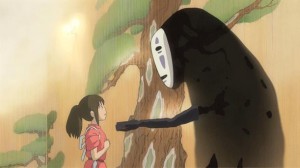
Hayao Miyazaki's Academy Award-winning 'Spirited Away' screens as part of the Studio Ghibli Festival, running Dec. 16 to Jan. 12 at New York's IFC Center. (GKIDS)
By JQ magazine editor Justin Tedaldi (CIR Kobe-shi, 2001-02) for Examiner.com. Visit his page here for related stories.
The holidays have come early for Studio Ghibli fans.
From Dec. 16 to Jan. 12, GKIDS will host a massive four-week film retrospective from Japan’s internationally acclaimed animation studio at the IFC Center in Greenwich Village.
Founded in 1985 and led by directors Hayao Miyazaki and Isao Takahata, Ghibli (based on the Arabic name for the sirocco, or Mediterranean wind) is home of some of the greatest anime films of all time, including the Academy Award-winning Spirited Away (also the highest grossing film in Japanese history), My Neighbor Totoro, Castle in the Sky, Princess Mononoke, Kiki’s Delivery Service and more. The studio even has its own museum in Tokyo, which recently celebrated its tenth anniversary and showcased two of its short films at Carnegie Hall in March in a rare a one-time-only exception to its screening policy.
For this first-ever Studio Ghibli Festival, all films will be shown on sparkling new 35mm prints, including the North American premieres of Takahata’s Only Yesterday and Tomomi Mochizuki’s The Ocean Waves.
The retrospective should also whet fans’ appetites for the next Ghibli film to be released in North America, The Secret World of Arrietty. Co-written by Miyazaki and based on Mary Norton’s award-winning novel series The Borrowers, Arrietty arrives in theaters Feb. 17.
For the complete story, click here.
Justin’s Japan: L’Arc~en~Ciel Marks 20 Years in Rock with Special Film Screening
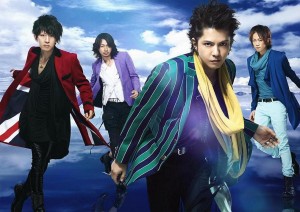
'The Best of L'Arc~en~Ciel 2 Days Live at Tokyo Ajinomoto Stadium' premieres Nov. 29 in New York. (Courtesy of Live Viewing Japan)
By JQ magazine editor Justin Tedaldi (CIR Kobe-shi, 2001-02) for Examiner.com. Visit his page here for related stories.
After 20 years, 13 million albums and 16 million singles sold, famed J-rock group L’Arc~en~Ciel is ready for its next career highlight: New York City.
On Nov. 29, movie theaters in Times Square and Union Square will unveil a special one-night-only music event for the band, which will be simulcast in eight other major American cities. The screening comes months ahead of their hotly anticipated live debut at the Theater at Madison Square Garden in March 2012.
Entitled The Best of L’Arc~en~Ciel 2 Days Live at Tokyo Ajinomoto Stadium, the concert film celebrates the group’s 20th Anniversary, traces their colorful history, and captures them in action at a gig last year that drew over 100,000 fans. The screening is presented by Live Viewing Japan in partnership with Maverick DC Group.
Live Viewing Japan is a distribution company focused on bringing Japanese entertainment media to an international audience. In New York earlier this month, they screened a concert showcase by superstar virtual idol Hatsune Miku (read this Examiner’s review here), and L’Arc~en~Ciel’s film has already made the rounds in São Paulo, Jakarta, Singapore, and will beam its way to London next month.
For the complete story, click here.
Justin’s Japan: Film Review – ‘Hatsune Miku Live Party 2011 39’s Live in Sapporo’
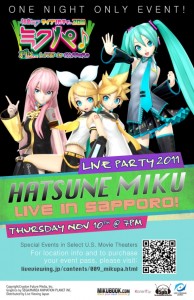
"With New York going bananas in between numbers and the room itself mimicking the Sapporo show with timed strobe and lighting effects—the theater’s management really went the extra mile—it truly felt like being at a concert." (Courtesy of Live Viewing Japan)
By JQ magazine editor Justin Tedaldi (CIR Kobe-shi, 2001-02) for Examiner.com. Visit his page here for related stories.
On Nov. 10 a one-time theatrical screening was held for a new concert film from virtual pop phenom Hatsune Miku. Entitled Hatsune Miku Live Party 2011 39’s Live in Sapporo, the film—captured in August at the 2,000 capacity Zepp Sapporo—is Miku’s latest appearance in America following a Toyota ad campaign and live gigs at L.A.’s Nokia Theatre and the San Diego Comic-Con earlier this year. (In fact, this reporter was interviewed for Japanese TV about that; click here for the news clip.)
Hatsune Miku, whose name means “first sound of the future,” is a Vocaloid (meaning machine-made vocals) digital female avatar and the most popular of Crypton Future Media characters that employ Yamaha technology to create synthesized vocal tracks, similar to Auto-Tune. In Japan, Miku is massively successful and has appeared in numerous popular video games and music videos, and her Sailor Moon-meets-Avril Lavigne image (she is a teen idol, after all) is equally fanboy and fangirl friendly.
Presented by Live Viewing Japan and simulcast in nine U.S. cities, this screening was shown to a capacity Times Square crowd. From the moment Miku’s name flashed up on the dark screen five seconds in, the audience was hooked. Wild applause, shrieks and excitement from the mostly American teens and twentysomethings in the crowd took the older folks by surprise. “This is like Paul McCartney to us,” remarked one lady several seats away. (She and her companion left about an hour in.)
For those unfamiliar with J-pop, the genre’s credo is style over substance (Katy Perry and Lady Gaga are our closest counterparts), but just like with our pop tarts, a catchy hook is a catchy hook. With a black, completely bare stage flanked by a five-piece band (yes, the music seems to be performed live), the only thing besides Miku noticeable throughout are the hundreds of lime green glow sticks pumped energetically by the fans throughout. Again, this was mirrored by the Times Square audience as one enterprising otaku passed out five blue ones (not to be outdone, he carried a massive Darth Maul-ish staff that lit up a chunk of the theater.)
For the rest of the article, click here.
JQ Magazine: Film Review – Sion Sono’s ‘Cold Fish’ an Antisocially Acquired Taste
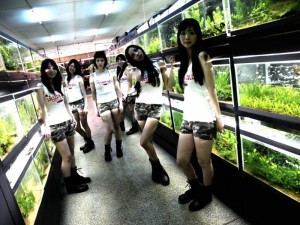
“In the end, Sono really does ask us about our humanity, and what life is about. Sure, he takes the bloody, abusive, rape-filled path, but he does touch on some solid stuff. It’s a lot of big questions wrapped in a gory, misogynistic, boob-exposing gift box.” (Courtesy Salient Media)
By Rick Ambrosio (Ibaraki-ken, 2006-08) for JQ magazine. Rick manages the JET Alumni Association of New York (JETAANY)’s Twitter page and is the creator of the JETwit column Tadaima!
I was hungry, real hungry after work and was about 20 minutes early to the New York Museum of Art and Design near Columbus Circle to see the movie Cold Fish 「冷たい熱帯魚」, so I walked a block to Good Burger and grabbed an overpriced hamburger. As I arrived back to the museum, I sat next to Shree (name changed to protect the innocent) who was midway through a burrito. With minutes left before the movie started, we headed into the museum and down some wooden steps to the theater. Walking in I was pretty surprised; we were only accompanied by seven or eight other patrons. Little did I know that it was a blessing in disguise…fewer people to feel awkward around after the movie.
Oh yes, the movie. How do I write about Cold Fish? It’s a little difficult. I suppose I can do it like this:
Cold Fish is a film directed by the controversial Sion Sono (whose month-long, eight-film retrospective wraps this week at MAD) and stars Denden and Mitsuru Fukikoshi. The film is based on real murders that took place in Fukushima. The story begins well enough: A timid man named Nobuyuki (Mitsuru Fukikoshi) with a rebellious daughter (Hiraki Kajiwara) and a hot trophy wife (gravure idol Megumi Kagurazaka) is feeling disconnected and regretful. They own a tropical fish shop. Through an awkward circumstance they meet Mr. Murata (Denden) and his attractive wife (Asuka Kurosawa), both of whom also own a tropical fish shop.
From there, shit just gets weird. That’s the only way I can explain it, folks. And it wasn’t just because the film cut out four times while we watched it. (Apparently, there were Blu-ray issues…through most of the movie. The museum might want to buy a new player before they hold another festival.) Anyway, Mr. Murata decides to bring Nobuyuki on as a partner, but not before hiring his daughter at his shop and sleeping with his wife (who apparently enjoys rough treatment, to put it mildly).
As Nobuyuki is introduced as the new partner, the old partner finds himself exiting the business via a poisonous death. This is where things kick into the next gear, and Murata forces Nobuyuki to assist with the disposal of the body. The whole body disposal process is presented with great detail. I’m serious about this part—after watching this movie, I am fairly confident that anyone could make a dead body disappear.
The plot then dives deeper and deeper into the dark comedy that is Murata’s utter disregard for human life and the director’s utter disregard for your stomach. By the way, did I mention that this film is very graphically violent? If you aren’t into that kind of thing, find another show; this movie revels in its ability to test what you can deal with gore-wise. If you enjoy severed heads and genitalia being tossed around a bathroom, you’ve found your dream movie.
Ghibli’s 借りぐらしのアリエッティ (aka “The Secret World of Arrietty”) being released in US Feb 2012!
Carolyn Brooks (Ishikawa-ken, Kanazawa, 2006-11) is co-author of the blog MadSilence–a cross-cultural blog written with her father–and a current culture/education related job-seeker in the NY area available for full-time or consulting work.
I was so excited when I saw a friend post on Facebook this morning that the most recent Hayao Miyazaki and Studio Ghibli film, “The Secret World of Arrietty” will be in theaters in the US in February of 2012! I was lucky enough to see it in theaters in July of 2010, and I was blown away. You can watch the Japanese trailer here.
The story is based off the classic children’s novel “The Borrowers” by Mary Norton. Essentially, the Borrowers are kobito, literally “tiny people,” who live by borrowing the things they need from humans. They live under the floorboards or close to human’s houses so they can sneak in when no-one’s around to borrow what they need. The main characters are Arrietty and her family, the last remaining Borrower family in their area. One day, while borrowing sugar from the house, Arrietty is seen by the sick boy who’s come to visit the house for the summer. What will happen now that a human has seen her? The adventure begins!
Studio Ghibli films are always beautifully produced, but I thought that Arrietty was even a step above their normal production. The scenery from the garden around the house was exquisite… every leaf, flower and dew drop was so fresh and colorful that when you watch it on the big screen you truly feel you are the size of a Borrower, walking though the jungle of an overgrown garden. The soundtrack was equally amazing – ethereal and quirky, performed by the immensely talented French singer and harpist Cecile Corbel. I’m not one for buying movie soundtracks, but after I saw the movie I immediately went to the closest Tower Records and bought the “Kari-gurashi SONGBOOK” soundtrack, which has all of the best themes and songs from the movie on it. Check out the main theme here.
Disney will be releasing Arrietty in February. Although I’m a die-hard subtitle fan, I’ve been really impressed by Disney’s translation and dubbing for the other Ghibli movies. They bring in top-notch actors and really smooth out the dialogue while keeping close to the original meaning and feeling of the Japanese. Translation of movies has got to be one of the hardest jobs ever – it’s not just language but a whole different set of cultural cues that you’re translating for another audience. Arrietty will be voiced by Bridget Mendler and supported by a great cast including Carol Burnett, Amy Poehler, and Will Arnet.
I know that most of us have seen or heard of Miyazaki’s movies before – perhaps Studio Ghibli’s movies are part of what drew us to Japan. Movies, anime, and traditional artwork were the things that got me interested in Japan in the first place! What are some of your favorite Ghibli movies? Mine include:
Porco Rosso (紅の豚 Kurenai no Buta), the Casablanca-esque story of a mysteriously enchanted pig-cum-bounty hunter who swoops around the Adriatic saving school children and the hearts of beautiful cafe owners…
My Neighbor Totoro (となりのトトロ Tonari no Totoro), a story of two little girls who move to a new house in the country with their father. Strangely enough, the house is inhabited by an amazing array or spirits that can only be seen by children, including the large, fuzzy, and toothy monster called Totoro and his friend the Cat Bus.
Howl’s Moving Castle (ハウルの動く城 Hauru no Ugoku Shiro), based on the Diana Wynne Jones YA book of the same name, is a light tale of love and magic with a twist of Miyazaki’s anti-war messages…
JET alum collaborates on documentary about photographers of Tohoku Disaster
****************
Here’s a unique and compelling short documentary–an academic non-profit venture–by JET alum Janak Bhimani (who has been studying at the Keio Graduate School of Media Design after hosting an online Japanese TV show in New York a few years ago) made with some of his Keio classmates. The film is about Tohoku post 3.11 from the point of view of the people who took photographs and was shown at a special session of the 2011 Tokyo International Film Festival. It was originally shown in 4K (which was part of Janak’s research).
Here’s the link: http://vimeo.com/31093347
lenses + landscapes from KMD 4KNarrative on Vimeo.
Janak says feel free to share with others as they’d like to get it shown in more places in Japan and elsewhere.
NHK coverage of JETAA Heartland film festival fundraiser from March 2011
**************
Here’s a link to coverage (including video) of JETAA Heartland’s Japanese Film Festival fundraiser for Japan earthquake/tsunami relief back in March 2011. The video features an interview with JETAA Heartland President Warren McAllen!
Here’s the video and article:
By: Beth Vaughn
OVERLAND PARK, Kansas – Two and a half weeks have passed since an earthquake struck Japan, triggering a huge tusnami that has killed more than 10,000 people. Another estimated 18,000 people are still missing.
Though time has passed, the disaster is still at the forefront of many minds in the Heartland.
All proceeds from the Greater Kansas City Japanese Film Festival Sunday afternoon at Johnson County Community College went directly to agencies working in the Japanese relief effort.
The Japan Exchange and Teaching Program Alumni Association and the Heart of America Japan-America Society are putting on the event.
The film festival was planned even before the quake shook Japan. The original purpose was to promote Japanese flims in the Heartland and to grow a greater understanding of Japanese culture.
This year’s films include Chocolate Underground, Harimaya Bridge and Red Beard.
JETAA also plans to send volunteers to Japan in the coming months to help rebuild areas that now face devastation.


